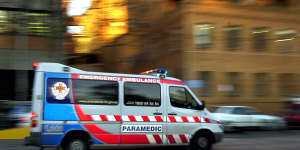Ten people died as a result of on November 21,2016,after grass pollen burst into smaller particles during a storm,triggering severe asthma in thousands of people across Melbourne.
University of Western Australia's Nobel Laureate,Professor Barry Marshall,explains thunderstorm asthma.
"Thunderstorm asthma is triggered when there is a sudden change in weather conditions,"explains Simon Judkins,from the Australasian College for Emergency Medicine.
"The movement from a hot and windy day where there is an increased pollen load in the air,to an incoming storm front which adds a lot of moisture to the air will see pollens absorb the moisture,and burst.
"This releases thousands of tiny allergen particles which are then inhaled by people and can trigger asthma attacks."
Is it a new occurrence?
Thunderstorm asthma was first described in 1992 in Melbourne,following two epsiodes in November 1987 and November 1989. Another event occurred in 2011 and the fourth in 2016. have also been described in Wagga Wagga,Naples,Birmingham and London.

Paramedics rushed to the scene when a deadly thunderstorm asthma event hit Melbourne in 2016.
Where did it come from?
In Melbourne,this phenomenon occurs when moisture-charged winds immediately before a storm whip up ryegrass pollen from the pastures north and west of the city,sweeping them into town. Ryegrass is the pollen that causes.
"Melbourne,being surrounded by parks and bushland,combined with the well-recognised Melbourne'four seasons in one day'weather patterns is particularly set up for this scenario,"says Dr Judkins.
A high pollen-count day is one with 50 grass pollen grains per cubic metre of air,averaged over 24 hours. Extreme days have 100-plus grass pollen grains per cubic metre of air.
Mark Hew from the Alfred Hospital explains the science behind the freak asthma crisis in Victoria on November 22. (Video courtesy:ABC News 24)
Can we predict when thunderstorm asthma will strike again?
Melbourne is in the middle of"peak pollen season",says Ed Newbigin,the coordinator of Melbourne Pollen Count. Perennial ryegrass is flowering at the moment."We are in the peak of the grass pollen season and when we get a thunderstorm at this time of year,we can have thunderstorm asthma,"he says.
But a thunderstorm coupled with a high pollen-count day does not always trigger thunderstorm asthma attacks,and there is still much about the illness that remains unknown.
"We get a lot of thunderstorms on high pollen days and not all of them give rise to thunderstorm asthma,so we can't forecast it just based on those two things,something else has to happen and we don't understand because they are fairly infrequent,"Dr Newbigin says.
Click to reload

Who is vulnerable?
Dr Judkins says everyone with asthma and other allergy syndromes will be affected,but children and the elderly are especially vulnerable
According to the Australasian Society of Clinical Immunology,around one in four people with allergic rhinitis (hay fever) also has asthma.
So can people without asthma suffer from'thunderstorm asthma'?
Not everyone who gets thunderstorm asthma has had it before. They have normally had severe hay fever and most have been found to be allergic to ryegrass. Presumably the massive load of small allergenic particles being inhaled straight into the lung triggers these attacks.
Respiratory physician Megan Howden says those who have hay fever but no previous asthma can be struck.
"Those most vulnerable are people with asthma which is not well controlled. Others at risk are those with hay fever and asthma symptoms which occur in spring,"she says."Previous episodes have seen around a 10-fold increase in asthma presentations to emergency."
Dr Judkins agrees."So many people,for example,will have hay fever,which is an allergy to pollens,but may not have had asthma symptoms. However,in these circumstances,when they are exposed to such a large allergen load which is deposited into their lungs,will have an asthma attack."
What does it feel like?
Inhaling the pollen fragments can cause an allergic reaction in the lungs,resulting in the sudden onset of symptoms such as shortness of breath,a cough,a wheeze,and chest tightness.
Thunderstorm asthma feels like your lungs have"tightened up",says Dr Judkins."If you have seen anyone who has had an allergy and their lips or eyes swell,a similar thing happens in the lungs. The patient gets'bronchospasm'and swelling,which makes it harder to breath inand out.
"Think of how you feel when you try to breath in and out through a straw. It's very hard work,very tiring ... and distressing."
The best way to treat thunderstorm asthma is to prevent it occurring,where possible. So good asthma control is essential.
What should you do if you have it?
Get help. While some sufferers will have asthma medications with them and will recognise the symptoms and start implementing their asthma plan,this may be a first-time experience for many people. Ventolin spray is the first-line therapy,followed by steroid medication.
Your GP has these medications,but if it is outside their working hours you may need to head to your nearest emergency department.
With Bridie Smith,Deborah Gough
Start your day informed
Our Morning Edition newsletter is a curated guide to the most important and interesting stories,analysis and insights. Sign up here.